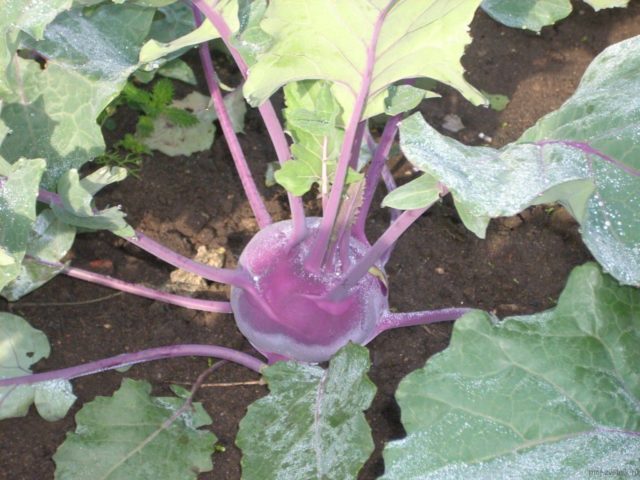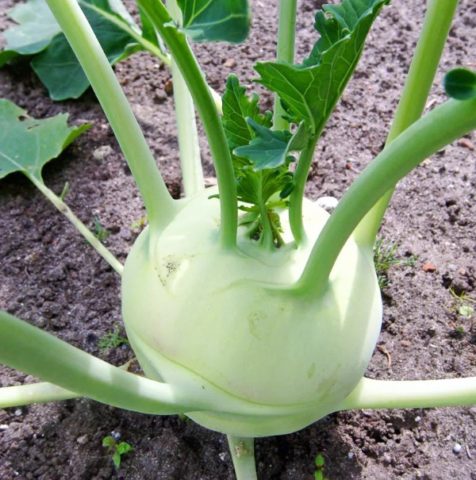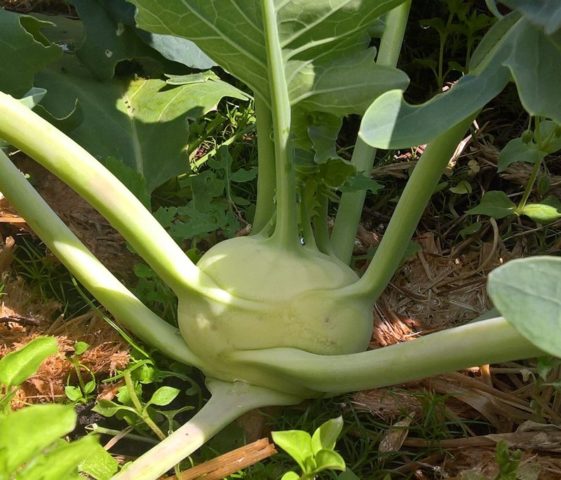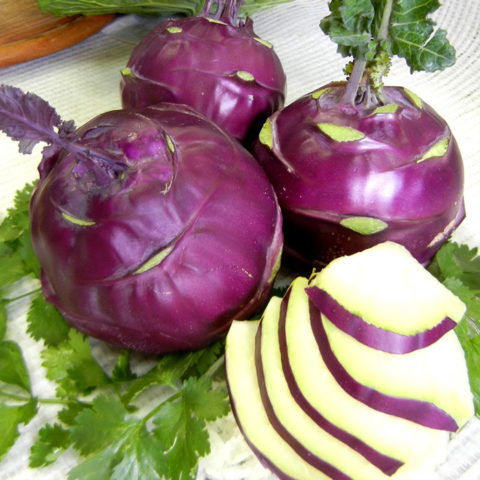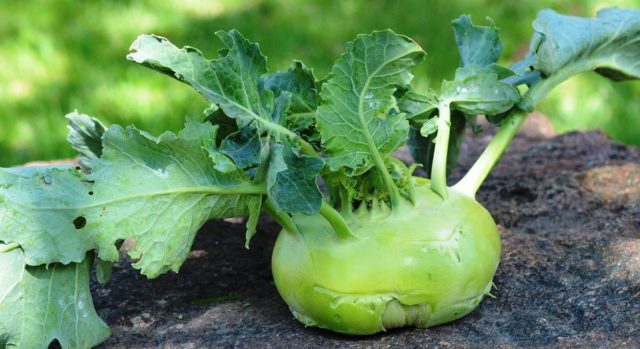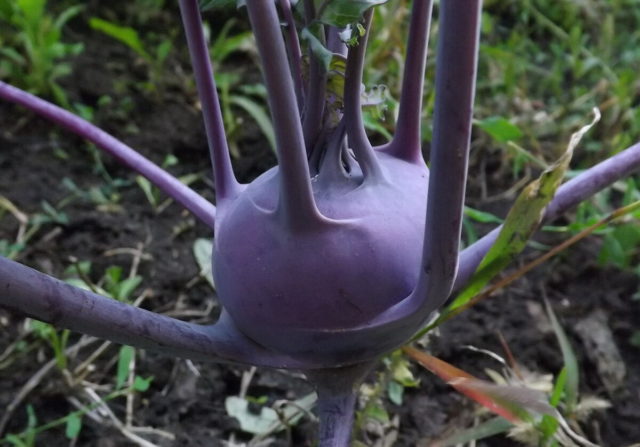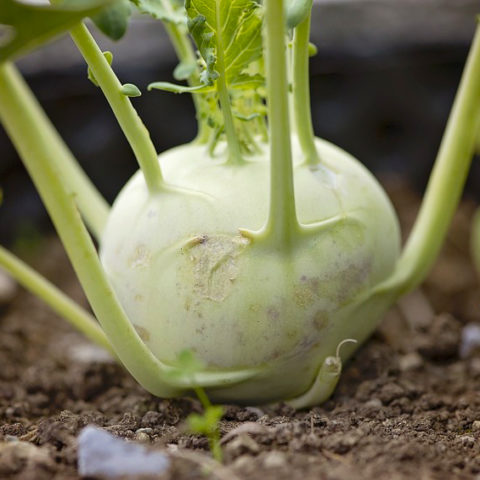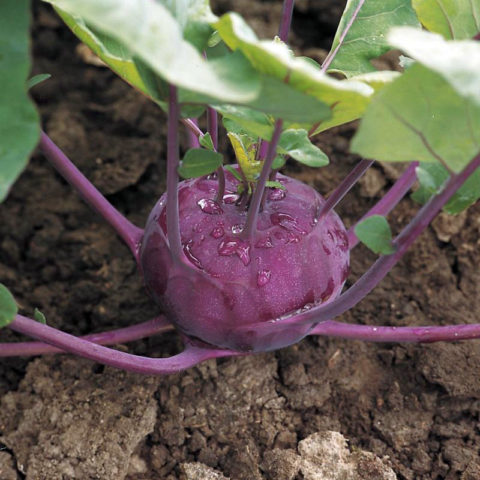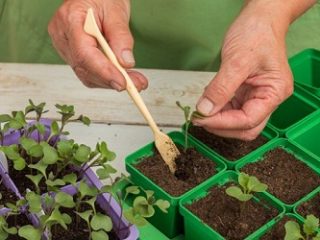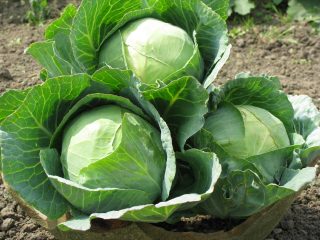Content
Unlike white cabbage, which has long been successfully cultivated on the territory of Russia on an industrial scale, other types of this crop are not so widespread. However, the trend has been changing in recent years. For example, kohlrabi cabbage is currently grown not only by amateur gardeners, but also by large farms, although it is still not as popular as its white cousin.
Description of kohlrabi cabbage
Scientists associate the appearance of kohlrabi with the Mediterranean region, namely with Ancient Rome. There, for the first time, there is a mention of this plant as the food of slaves and the poor. Gradually, kohlrabi spread to neighboring countries, but this culture gained wide popularity only after it was cultivated in Germany. Kohlrabi also owes this country its modern name, which literally translates from German as "turnip cabbage".
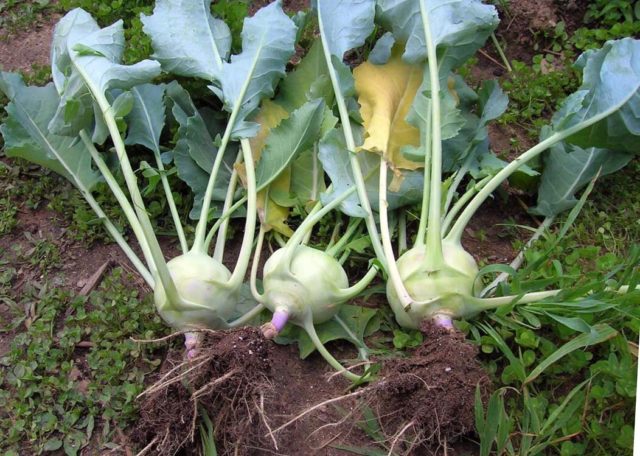
Fruit part - thickened spherical stem
The main difference between kohlrabi and ordinary white cabbage is the absence of the so-called head of cabbage - a rounded formation of leaves tightly adjacent to each other. Despite this, the structure of these two plant species is very similar. The fruiting body of the kohlrabi is the stem-grower - a very thickened stem of the plant. In fact, this is the same stump, however, it is not cone-shaped, like in white cabbage, but spherical.
The standard weight of the stem is in the range of 0.3-0.5 kg, but in some varieties this figure may be several times higher. The taste of kohlrabi pulp strongly resembles an ordinary cabbage stump, however, it is softer and more harmonious, it does not have the harshness inherent in white cabbage species. In the context of the stem crop, it has a white or slightly greenish color. Kohlrabi cabbage also has leaves, they are few in number, ovoid or triangular in shape, with strongly elongated petioles. Unlike ordinary cabbage, they are usually not used for food.
The best varieties of kohlrabi cabbage
Depending on the ripening time, all varieties of kohlrabi cabbage are combined into several groups:
- Early maturing (up to 70 days).
- Medium early (70-85 days).
- Mid-season (85-110 days).
- Late ripening (over 110 days).
Types of kohlrabi of various ripeness periods, their photos and a short description are given below.
Early maturing varieties
Early ripening varieties take 45 to 65 days to reach removable ripeness. Their main application is fresh consumption due to low keeping quality and transportability.
These include:
- Sonata F This hybrid matures in 60-65 days. The stemfruit is round, weighing about 0.5 kg, beautiful lilac-purple color. Leaves are oval, grayish-green, with a bluish bloom and purple veins. The taste of white dense pulp is pleasant, harmonious, without pungency.
Sonata is one of the early ripening hybrids
- Vienna White 1350... This variety of kohlrabi cabbage was bred in the Soviet Union in the middle of the last century; it has been successfully grown by many gardeners for a long time. The stemfruit is medium-sized, up to 200 g, rounded-flattened, greenish-white. The rosette of leaves is not numerous and low. The Viennese white 1350 ripens in 65-75 days. Used fresh.Important! Cabbage of this species is resistant to shooting, however, it has weak immunity from keel.
Vienna 1350 - a product of Soviet breeders
- Piquant... Reaches ripeness in 70-75 days.Rosette of large oval leaves, half-raised. The fruit is round, slightly flattened, greenish with a creamy tinge. In good conditions, its weight can reach 0.9 kg, but usually the average weight of the crop is in the range of 0.5-0.6 kg.Important! It has good resistance to woodiness, does not crack, and is well stored with late planting.
Piquant can grow to a significant size
Medium early varieties
The varieties with medium early ripening include:
- Moravia... A variety of Czech selection that appeared in Russia at the end of the last century. The stem fruit is medium in size, about 10 cm in diameter, greenish-white. The socket is small, semi-vertical. Differs in juicy white pulp and a pleasant rich taste. The ripening period of Moravia is about 80 days.Important! Moravia is prone to overgrowth.
Moravia has a good harmonious taste
- Gusto... This variety of kohlrabi cabbage takes 75-80 days to ripen. The stem crop is slightly larger than average, its weight usually ranges from 0.5-0.7 kg. Raspberry skin, thin. The pulp is white, juicy, with a good soft taste.
The relish has an unusual color - crimson
- Vienna blue... It matures a little longer than Vienna White, taking about 80 days to fully ripen. The color of the peel of the stem is purple, the petioles and leaves have the same shade. The leaves are green, few in number, the rosette is small. The pulp is white, of pleasant taste, very juicy.
Vienna blue is a very famous variety
Mid-season varieties
Mid-season kohlrabi cabbage is more versatile. In addition to fresh consumption, it can be canned. She has good keeping quality and transportability.
The most popular varieties:
- Cartago F This is a productive hybrid of Czech breeding with a ripening period of about 100 days. It has a vertical rosette of dark green oval leaves covered with a waxy coating. The average weight of stems at maturity is 300 g. They are pale green, with a delicate white flesh inside. The taste is pleasant, there is no sharpness.Important! The hybrid is resistant to woodiness and cracking.
Hybrid Cartago F1 - a gift from Czech breeders
- Blue planet F The stem fruit of this kohlrabi cabbage hybrid at the stage of ripeness reaches a weight of 0.2-0.25 kg. It is rounded, light green with a bluish-blue tint. The pulp is white, firm, and has a pleasant taste. The ripening period for kohlrabi Blue Planet F1 is 110-115 days.
The stem fruit has a very unusual shade - blue
- Vienna blue... Its ripening period is 90-95 days. The fruits are small, weighing about 0.2 kg, lilac-purple in color with a bluish bloom. The peculiarity is that the stem grower is not located on the ground, but above it. Because of this, Vienna Blue almost never outgrows.
Vienna blue grows quite high above the ground
Late-ripening varieties
Late varieties of kohlrabi cabbage are the largest in size. Due to the thick skin and dense pulp, they retain their commercial properties for a long time, they have an increased shelf life. Late ripening kohlrabi can be canned, put into industrial processing or consumed fresh.
Popular varieties:
- Giant... This kohlrabi cabbage is really gigantic in size. A stemfruit in the stage of maturity has a circumference of about 20 cm and can weigh up to 5 kg, while its standard weight is 2.5-3.5 kg. The rosette of leaves is also large, about 0.6 m in diameter. It takes 110-120 days to ripen. Gardeners unanimously note the unpretentiousness of the Giant, which can grow in almost any region of Russia.Important! Even with such a significant size, the Giant has a good taste, not inferior to early cabbage.
The giant lives up to its name
- Hummingbird... Dutch variety. The leaves are bright green, the rosette is semi-vertical. Ripens in about 130-140 days. The stem fruit is oval, lilac, with a bluish bloom, its average weight is 0.9-1 kg. The taste is sweet, soft and delicate, the pulp is very juicy.
Hummingbird - kohlrabi of the Dutch breeding school
- Violet... The rounded purple stems of this kohlrabi cabbage ripen in 130-135 days. The average weight of each of them is 1.5 kg. The pulp is firm and juicy, with a good soft taste. The variety is resistant to many diseases, unpretentious. Gardeners love it for its high yield, which is about 4 kg per 1 sq. m.
The yielding variety Violetta is loved by many summer residents
Storage rules for kohlrabi cabbage
In order to keep kohlrabi fresh longer, you need not only to prepare the place in advance, but also to harvest on time. Here are some tips to help you do it right:
- Kohlrabi is stored on a clear day when the air temperature drops to + 3-5 ° C.
- If long storage is planned, then the roots of the stem plants are not cut off. They are pulled out together with the ground, the stems are cut off, leaving small stumps, and then stored.
- Red (purple) kohlrabi varieties are stored better than white ones. This must be taken into account when planning the landing.
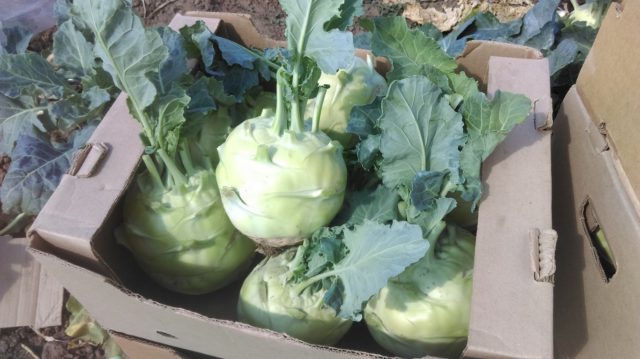
White kohlrabi has a very short shelf life
It is best to store kohlrabi cabbage for a long period in a cellar with a minimum positive temperature and high humidity. Plucked heads of cabbage can be stuck with roots in the sand or hung on ropes by them so that the stems do not touch each other. For short-term storage, the fruits can be placed in wooden boxes. In this case, they do not need to be washed.
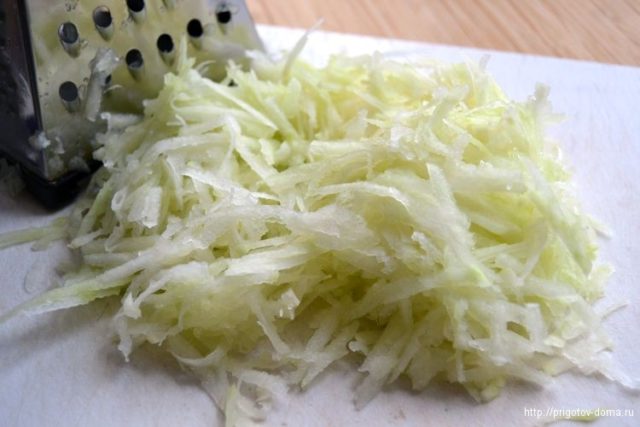
Before freezing, the vegetable must be grated.
Another way of long-term storage of kohlrabi cabbage is deep freezing. In this case, the stalks are peeled and rubbed on a coarse grater. Then the semi-finished product is laid out in bags and put into the freezer. The shelf life of frozen kohlrabi is 9 months.
Conclusion
Kohlrabi cabbage is an excellent garden plant that can be used to prepare a variety of dishes. However, it is worth remembering that the stem of the plant is capable of accumulating nitrates in the same way as the cabbage stump does. Therefore, when cultivating a crop, it is advisable not to use nitrate fertilizers.
